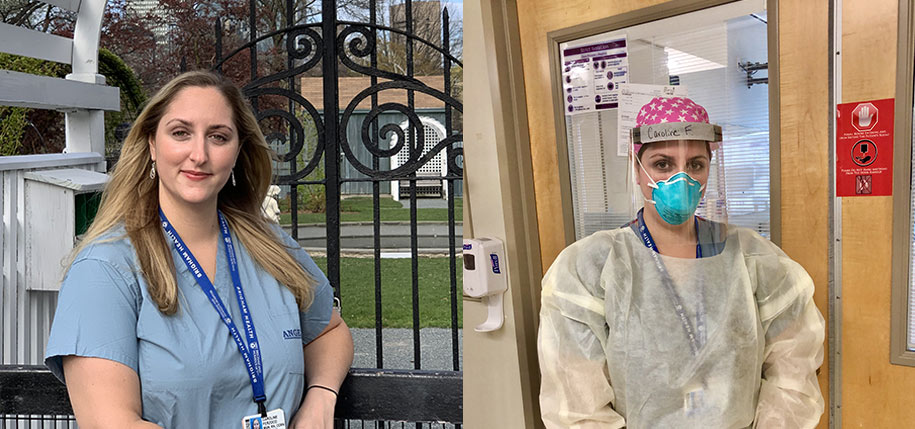
By Caroline Ferzoco, MSN, RN, ICU Float Pool
The STAT team of nurses at Brigham and Women's Hospital has been responding to emergencies for years, but during this difficult time, the team's role is more vital than ever. This team of dedicated critical care nurses are there for COVID-19 patients during their most vulnerable moments: when their lungs and oxygenation status buckle beneath the pressure of the virus.
Our four-person team starts the shift by switching off with the nurses who worked overnight. As we sit down at the large conference table, making sure to have appropriate distance between us, I notice the tired expressions on each face. It's a common misconception that a hospital slows down overnight, as most of the world does, but COVID-19 and critical illness do not run on any timeline.
I position my pager, phone, emergency bag and walkie talkie securely to my scrubs so that my team and I can stay in communication with one another. As I swing a backpack of emergency supplies over my shoulder, I feel the heaviness of the bag that will surely intensify throughout my 12-hour shift. These "STAT bags" are our lifelines to the critical equipment needed during emergencies when we can't wait a minute longer for the supplies to get to us because our patient's life depends on it.
Lastly, I make sure that I have my PPE (personal protective equipment) bag in hand. We never know where or when an emergency will occur, which means we need our gear at all times. This bag is where I keep my face shield and N95 respirator that I will re-use for the shift. This ordinary brown paper bag is now carrying our most important items of the shift; it provides us with the ability to go into patients' rooms safely to perform life-saving care.
Before this pandemic, each floor in the hospital housed specific patient populations, but with the increase of COVID-19 positive patients, nurses from all specialties come together to treat these patients. Now these units are delineated as either SPU (special pathogens unit) or SP-ICU, meaning COVID-19 patients or PUIs (persons under investigation) who are non-ICU and those requiring ICU care, respectively.
There is a constant ebb and flow between these two areas, as some patients improve and some decline. As STAT nurses, we are often only involved in the declining side with patients who are getting worse, the ones who will need their care escalated to the ICU. And although this might seem somber, a job in which you only see the worsening side of things, we thrive on being there for our patients during these scary moments and providing them with the critical care they need.
Only a short time into the shift and the first rapid response occurs—a patient is in distress. Our respective pagers all begin their chorus of chirps as we look to see where we're needed. We move swiftly to one of the buildings that houses COVID patients.
As we arrive at the patient's room, I see the familiar influx of staff waiting, with the code cart positioned in hand. As I peek through the closed door, I instantly understand why we're here. I see the primary nurse setting up a non-rebreather mask, and a patient lying on the bed gasping for breath. The patient's breathing is extremely labored, and that means we have to act immediately.
It's determined quickly that this patient will need a breathing tube; therefore, we promptly spring into action to prepare for the airway team's arrival. We split off into who will be heading into the room to assist and who will be stationed outside the door preparing all the supplies and medication. We take turns as the code RN in the room so that we can better preserve our PPE, each one of us knowing that we'll all likely take a turn this shift as this outcome affects many with COVID-19. Before I can even ask if certain supplies are ready, I watch as my team member's hands start to move without any discussion, as if muscle memory has taken over. The task work just begins to flow as everyone pitches in.
I gear up, knowing that I will likely be in the room for a long period of time. Often hours can go by before stabilizing a patient or until we can get the patient transferred to the ICU. My observer, a patient care assistant on the floor, helps me don my PPE in the meticulous method needed to keep me protected before heading in. I grasp the patient's hand softly to introduce myself and let her know that I am going to help her. I can see the airway team outside the room gearing up for the intubation and know there are only a few moments left for the patient to speak with family. The patient smiles upon hearing a loved one’s voice on the phone; the patient is unable to say much due to fatigue, but the family does an amazing job of letting them know how much they are loved, repeating it over and over.
As I hear the door to the room open, I have them say their goodbyes, and I tell the family member that I will be there, holding the patient’s hand the whole time. The anesthesia team enters, and we get into go-mode. I settle in to the familiar beeping of the pulse ox machine as we administer the medicine to make the patient fall asleep. And only a few moments later, the tube is in, the ventilator attached, and we are heading off with the patient to the ICU.
About halfway to our destination, my breathing starts quickening as I feel the effects of transporting a patient while wearing a respirator, but I do my best to take deep breaths. Anyone who has tried to run or exercise while wearing a mask during this pandemic might understand that instinct of wanting to rip the mask off immediately to get some air. But my duty as a nurse to my patient and to the safety of all others kept me level-headed to get this patient to the ICU as safely and swiftly as possible.
As we head into the ICU room to settle the patient in, I notice how peaceful they look. The patient’s lungs were no longer straining to breathe as the ventilator took over the work for them. And although I know the patient has a tough journey ahead, I also know there is a team of dedicated health care workers behind them.
My team and I leave once we've transitioned care to the ICU nurse who will be taking over. I often don't see patients after these kinds of encounters, but I take great comfort in knowing I've passed off to a wonderful team of nurses. As we step into the elevator, we all take a deep breath of relief that we were able to help the patient in time. But our minds don't have much time to linger, as our pagers sound off again, and we're called to help someone else in need, right away.
For over a century, a leader in patient care, medical education and research, with expertise in virtually every specialty of medicine and surgery.
About BWH
